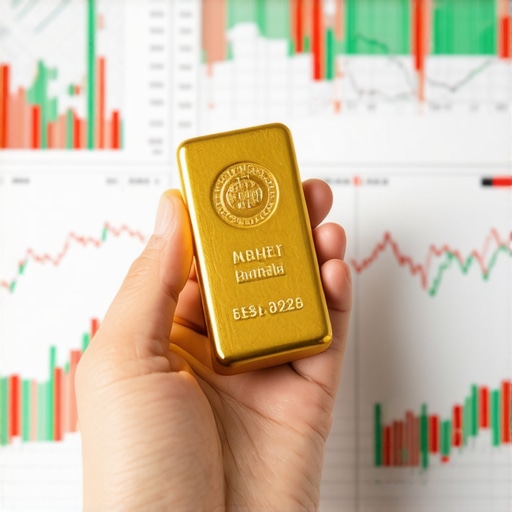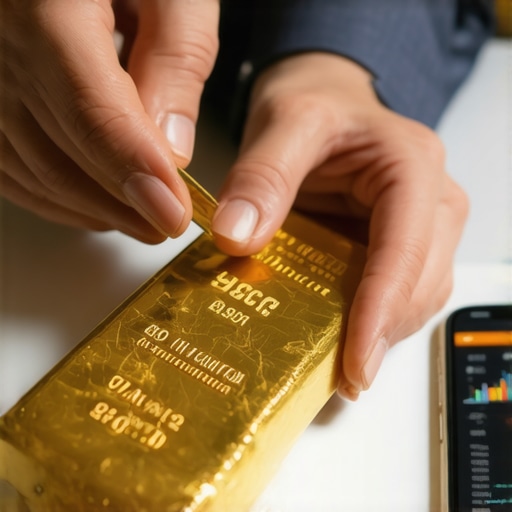Understanding the Role of Gold in Investment Diversification
In today’s unpredictable financial landscape, investors are increasingly recognizing the significance of gold as a cornerstone of a diversified portfolio. The growing importance of gold stems from its unique properties as a tangible asset, a hedge against inflation, and a safeguard during economic downturns. Investors looking to enhance their portfolio stability often turn to gold, which has historically maintained its value over time.
The Historical Significance of Gold in Investments
Gold has been a symbol of wealth and prosperity for centuries, serving as a reliable medium of exchange and a store of value. Its enduring appeal can be attributed to its scarcity and the universal demand across cultures. Unlike fiat currencies, which can be subject to inflationary pressures, gold tends to hold its value, making it an attractive option for those looking to protect their investments against market volatility.
Gold as a Hedge Against Inflation
One of the most compelling reasons to include gold in your investment strategy is its ability to act as a hedge against inflation. As the cost of living increases and currency values fluctuate, gold often appreciates in value, preserving purchasing power. This characteristic makes it a critical component for investors aiming to protect their wealth in times of economic uncertainty. According to recent analyses, the understanding of gold as a hedge against financial crises is key for making informed investment decisions.
Portfolio Diversification Benefits
Incorporating gold into a diversified portfolio can significantly reduce overall risk. Gold’s low correlation with other asset classes, such as stocks and bonds, allows it to perform well even when other investments falter. This trait is particularly valuable during market downturns, where gold often sees increased demand. By allocating a portion of your investments to gold, you can enhance your portfolio’s resilience and improve your long-term financial outlook.
Conclusion: The Case for Gold Investments
The growing importance of gold in a diversified portfolio cannot be overstated. With its historical significance, ability to hedge against inflation, and benefits for portfolio diversification, gold represents a wise investment choice for individuals seeking stability in their financial planning. For those new to investing in gold, exploring options such as different types of gold investments can provide valuable insights into how to effectively integrate gold into your overall investment strategy.
Evaluating Gold Investment Opportunities
When considering gold as a viable investment, it’s essential to evaluate various opportunities available in the market. Investors can choose to invest in physical gold, such as coins and bars, or opt for gold-based financial products like ETFs and mutual funds. Each option has its unique advantages and risks, which should be understood before making any financial commitments. For instance, exploring different types of gold investments can help individuals identify the best fit for their financial goals.
Physical Gold vs. Financial Instruments
Investing in physical gold provides tangible assets that can be stored and secured, offering a sense of ownership that financial instruments cannot replicate. However, it also entails responsibilities such as storage and insurance. Conversely, gold ETFs and mutual funds offer liquidity and ease of trading, allowing investors to gain exposure to gold prices without the complications of handling physical assets. This trade-off is vital for investors to consider based on their comfort level and investment strategy.
The Role of Gold in Economic Uncertainty
Gold has historically performed well during times of economic uncertainty, often viewed as a safe haven asset. When markets are volatile, investors flock to gold, driving up its price. This phenomenon underscores the importance of gold as part of an investment strategy that aims to mitigate risks associated with economic downturns. Understanding how gold reacts during financial crises can enhance your investment approach. For a deeper dive into this aspect, refer to our article on how global demand impacts gold prices.
Strategic Factors Influencing Gold Prices
Several factors influence gold prices, making it crucial for investors to stay informed. Key elements include global economic indicators, geopolitical tensions, and changes in currency values. For instance, when inflation rises, gold typically becomes more attractive as a protective investment. Additionally, central bank policies regarding gold reserves can significantly impact market dynamics. Keeping an eye on these strategic factors is essential to navigate the complexities of gold investment.
The Impact of Central Bank Policies
Central banks play a pivotal role in the gold market, influencing supply and demand through their purchasing strategies. When central banks increase their gold reserves, it often signals confidence in gold as a secure asset. This can lead to price increases, making it essential for investors to monitor central bank activities. For insights on this topic, consider reading about central bank gold purchases.
Global Economic Indicators
Global economic health directly affects gold prices. Economic reports, interest rates, and employment data can all sway market sentiments. Investors should stay abreast of these indicators to make informed decisions about their gold investments. For a comprehensive understanding of current market conditions, check out top factors influencing gold prices.
Conclusion: Making Informed Decisions in Gold Investment
Investing in gold presents numerous benefits, from diversification to acting as a hedge against inflation and economic uncertainty. By evaluating various investment opportunities and understanding the factors that influence gold prices, investors can make informed decisions that align with their financial goals. For those looking to start their journey, our guide on investing in gold for beginners offers essential insights to navigate this exciting market.
Investment Strategies for Gold: Maximizing Returns
To achieve success in gold investment, it’s essential to develop a robust strategy that aligns with your financial objectives. Consider diversifying your portfolio by incorporating a mix of physical gold, such as bullion and coins, along with gold ETFs and mining stocks. This approach can help mitigate risks while providing exposure to different aspects of the gold market. Furthermore, utilizing tools like gold price forecasts can inform your timing and buying decisions.
Timing the Market: When to Buy Gold
Market timing can significantly influence your returns on gold investments. Investors often seek to purchase gold when prices are low or during periods of economic uncertainty. Analyzing historical price trends and current market conditions, such as inflation rates, can assist in identifying the optimal times to invest. For instance, during inflationary periods, gold tends to perform better, making it a favorable asset to consider. For detailed analysis on market conditions, explore our insights on gold market analysis.
Benefits of Gold Mutual Funds and ETFs
Gold mutual funds and ETFs offer unique advantages, such as professional management and lower investment thresholds compared to physical gold. They provide investors with liquidity and ease of access, allowing for quick buying and selling based on market movements. For those looking to maximize their investment potential, understanding the best practices for gold ETFs is crucial.
Understanding Gold Demand Trends: Key Insights for 2025
Monitoring gold demand trends is vital for making informed investment decisions. Key drivers of gold demand include jewelry consumption, industrial uses, and investment flows. As we approach 2025, understanding the changing landscape of these factors will be crucial for investors.
The Jewelry Market: A Significant Driver of Demand
The jewelry sector remains one of the largest consumers of gold. Cultural factors and economic growth in emerging markets, particularly in Asia, can significantly influence gold demand. Keeping an eye on trends in jewelry consumption can provide insights into potential price movements. For more information on the broader impact of demand, check out our article on gold demand trends.
Investment Demand: Gold as a Safe Haven
Investment demand for gold often spikes during periods of economic uncertainty or geopolitical tensions. Investors typically flock to gold as a hedge against inflation and currency devaluation. Understanding these patterns can help investors anticipate market movements and adjust their portfolios accordingly. To delve deeper into the role of gold in financial crises, refer to our guide on gold as a hedge.
Conclusion: Building a Sustainable Gold Investment Portfolio
In summary, understanding the dynamics of gold investment involves evaluating various opportunities, crafting informed strategies, and monitoring market trends. By leveraging insights on evaluating gold investment opportunities, investors can build a sustainable portfolio that aligns with their financial goals and risk tolerance. As the gold market evolves, staying informed and adaptable will be key to successful investing in this precious metal.
The Importance of Gold in Economic Recovery: Strategies for Investors
As global economies continue to navigate the challenges posed by inflation and uncertainty, gold remains a crucial asset for investors. Understanding the significance of gold during economic recovery is essential for making informed investment decisions. This section will explore how gold can act as a stabilizing force in your portfolio while providing strategies to maximize returns.
Gold as a Hedge Against Inflation
In times of rising inflation, gold is often viewed as a safe haven. Its intrinsic value tends to hold, making it a reliable store of wealth. Investors should consider allocating a portion of their portfolio to gold as a protective measure against the eroding purchasing power of currency. Learn more about why gold is a smart investment in economic uncertainty.
The Role of Central Banks in Gold Demand
Central banks play a significant role in shaping gold demand trends. Their policies, including gold purchases, directly influence market dynamics. Understanding how central bank strategies impact gold prices is vital for investors. For a deeper insight into this topic, explore our article on central bank gold purchases and their market implications.
Adapting to Market Conditions: Investment Strategies
To navigate the evolving gold landscape, investors must adapt their strategies. This includes staying informed about key economic indicators and market trends. Regularly reviewing your gold investment portfolio can help ensure alignment with your financial goals. Consider diversifying your investments across various types of gold assets, such as ETFs, mining stocks, and physical gold.
Future Trends: What to Expect in Gold Investing
Looking ahead, several trends are likely to shape the gold market. With increasing demand from emerging markets and the potential for renewed inflation, gold may become even more attractive to investors. Staying ahead of these trends will be crucial for maximizing returns.
Emerging Markets and Gold Demand
Emerging markets, particularly in Asia, are projected to drive gold demand significantly. As these economies grow, the consumption of gold for jewelry and investment purposes is expected to rise. Investors should keep an eye on these developments to capitalize on potential opportunities. For insights into how global demand impacts prices, refer to our analysis on global demand and gold prices.
Technological Advances in Gold Trading
Technology is also transforming the gold investment landscape. Advances in trading platforms and the rise of digital gold assets are making it easier for investors to access and trade gold. Understanding these innovations can provide a competitive edge in the market. For those exploring digital options, our guide on digital vs. traditional gold investments offers valuable insights.
Comprehensive FAQ Section on Gold Investing
What makes gold a good investment during economic uncertainty?
Gold is considered a strong investment during economic uncertainty due to its historical role as a safe haven. It tends to retain its value when currency values decline, making it a reliable store of wealth. Investors often turn to gold as a hedge against inflation and market volatility.
How can I invest in gold?
There are several ways to invest in gold, including purchasing physical gold (such as coins and bars), investing in gold exchange-traded funds (ETFs), buying shares in gold mining companies, or utilizing gold futures contracts. Each method has its own advantages and risks, so it’s important to choose based on your investment strategy and goals.
What are the risks associated with investing in gold?
While gold can be a stable investment, it does come with risks. These include market volatility, storage costs for physical gold, and the potential for lower returns compared to other assets during bullish market conditions. Investors should carefully assess their risk tolerance and investment horizon.
How does central bank policy affect gold prices?
Central banks influence gold prices through their buying and selling activities. When central banks increase their gold reserves, it typically drives up demand and prices. Conversely, if they sell significant amounts of gold, it can lead to price declines. Understanding central bank policies is crucial for predicting market movements.
What are the benefits of diversifying with gold in my investment portfolio?
Diversifying with gold can reduce overall portfolio risk. Gold often exhibits a low correlation with other asset classes, meaning it can provide stability when stocks and bonds are underperforming. This diversification can help maintain value and protect against market downturns.
Is investing in gold mining stocks a good idea?
Investing in gold mining stocks can be lucrative, as these companies may offer higher returns than physical gold, especially during rising gold prices. However, they come with additional risks, including operational challenges and market fluctuations. It’s important to research individual companies and their performance before investing.
How can I track gold prices effectively?
Gold prices can be tracked through various financial news outlets, market analysis websites, and dedicated financial apps. Additionally, platforms like the London Bullion Market Association (LBMA) provide real-time gold price updates. Staying informed about market trends and economic indicators is essential for making timely investment decisions.
What role does jewelry demand play in the gold market?
Jewelry demand significantly impacts the gold market, particularly in countries like India and China, where gold jewelry is culturally significant. As these markets grow and evolve, increased demand for gold jewelry can drive prices higher, making it an important factor for investors to monitor.
How can I protect my investment in physical gold?
To protect your investment in physical gold, consider using secure storage solutions, such as safe deposit boxes or professional vaults. Additionally, obtaining insurance for your gold holdings can provide an extra layer of security against theft and loss.
What is the outlook for gold prices in the next few years?
The outlook for gold prices will largely depend on economic indicators, such as inflation rates, central bank policies, and global demand trends. With ongoing economic uncertainties, many analysts predict that gold will continue to be a strong investment option, especially as more investors seek safe havens.
Authority Resources for Gold Investing
For further insights and expert guidance on gold investing, consider the following trusted resources:
- World Gold Council – A leading authority on gold, providing research and insights into gold demand, investment trends, and market dynamics.
- Kitco – A well-respected source for market prices, news, and analysis of precious metals, including gold.
- Investopedia – Offers a wealth of information on investment strategies, including comprehensive articles on gold investing.
- Gold.org – The official website of the World Gold Council, featuring in-depth reports and statistics on gold supply and demand.
- BullionVault – A platform for buying and selling physical gold, providing market insights and resources for investors.
- MarketWatch – Provides up-to-date financial news, including market analysis and trends affecting gold prices.
Conclusion: The Value of Gold in Your Investment Strategy
In conclusion, gold continues to be a vital asset for investors navigating economic uncertainty and seeking stability. By understanding its importance, adapting investment strategies, and utilizing expert resources, you can effectively incorporate gold into your portfolio. As trends evolve, staying informed will ensure you maximize your returns while mitigating risks. Invest in gold not just as a commodity but as a strategic asset that enhances your financial resilience.










